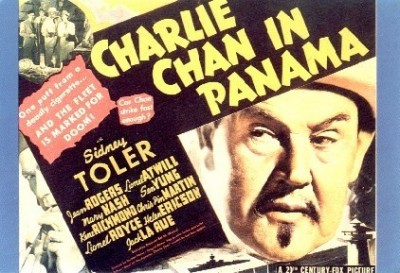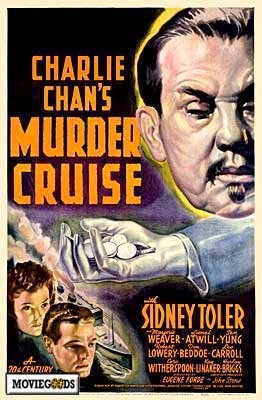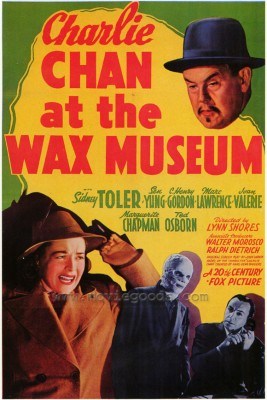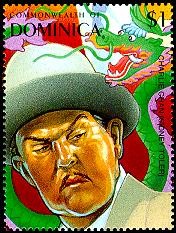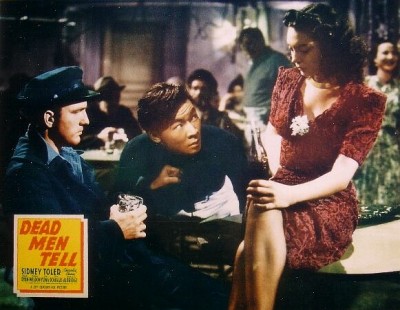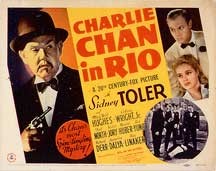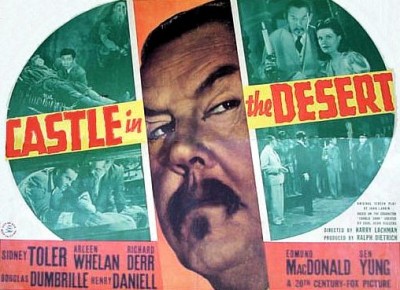| Reviews & Columns |
|
Reviews DVD TV on DVD Blu-ray 4K UHD International DVDs In Theaters Reviews by Studio Video Games Features Collector Series DVDs Easter Egg Database Interviews DVD Talk Radio Feature Articles Columns Anime Talk DVD Savant Horror DVDs The M.O.D. Squad Art House HD Talk Silent DVD
|
DVD Talk Forum |
|
|
| Resources |
|
DVD Price Search Customer Service #'s RCE Info Links |
|
Columns
|
|
|
Charlie Chan Volume 5
Considering earlier volumes had exhaustively explored the series from nearly every angle, the lack of supplements beyond one featurette, trailers and still galleries is no great loss, except maybe for Victor Sen Yung fans hoping for the same kind of profile given other series regulars. The films also got a lot shorter near the end of their run at Fox, so stretching the boxed sets into two more volumes would have been pushing it. All-in-all, this is a great bargain for Charlie Chan fans, and while the films definitely are several notches below the best Warner Oland entries, they're still fun in their own way, they still have production values unusually high for B-movie mysteries, and Fox's DVD transfers are outstanding.
"Intelligent defense of nation best guarantee for years of peace."
...So Charlie says at the end of Charlie Chan in Panama (1940): an ironic, and as it turns out dead wrong aphorism about American isolationism, in this entry made well into the start of World War II but still almost two years away from Pearl Harbor. Worries that the Canal would be sabotaged by the Germans or Japanese was on everyone's mind in the early 1940s - it also factors into the plot of Across the Pacific, John Huston's film with Humphrey Bogart - and this story really introduces in a big way Charlie's conscription, like virtually every popular movie character from Sherlock Holmes to Tarzan, into war effort entertainments, B-films lacquered with heavy swaths of propaganda.
Charlie is introduced working undercover in Panama City, as Panama hat shop proprietor Fu Yuen, unusual until you consider the script was originally planned as a Mr. Moto espionage thriller. Chan's on the trail of a mysterious saboteur named Reiner, who in turn has murdered Charlie's U.S. intelligence liaison, Godley (Addison Richards) with poisoned cigarettes slipped into his coat pocket by one of several suspects aboard a Douglas "Dolphin" flying boat. They include Czech refugee Kathi Lenesch (Jean Rogers), on her way to a job singing at a cabaret owned by Emil Manolo (Jack La Rue), also on board; British novelist Clivedon Compton (Lionel Atwill); schoolmarm and mystery-lover Sarah Finch (Mary Nash); a scientist whose specialty is bubonic plague, Dr. Rudolph Grosser (Lionel Royce); tobacco shop owner Achmed Halide (Frank Puglia); and U.S. government engineer Richard Cabot (Kane Richmond). Charlie's over-eager Number Two son, Jimmy (Victor Sen Yung) turns up later in the story to assist his beloved "Pop," though from the way he keeps blowing Charlie's cover from film-to-film you begin to wonder just whose side he's on.
Though rather generic, Charlie Chan in Panama is interesting for the way it acknowledges the war without ever naming any of the major players. The words "Germany" and "Nazi" are never spoken, only lines referring to the "cruelty of the invaders [of Europe]" and their "concentration camps."
As a mystery this one's rather predictable, but there's a successful effort to wring some suspense out of Charlie's attempts to prevent a portion of the canal from being blown up while he and several other principals have been locked in an old tomb for safekeeping. This and an adjacent graveyard are beautifully designed sets (credited to Richard Day and Chester Gore) full of atmosphere, suggesting Fox should have made more Gothic horror films. The cast has fun with the material, and it's nice to see actress Jean Rogers in a role other than Dale Arden, which she played in the first two Flash Gordon serials. (Indeed, probably the reason she's not in the third one was because she was making this at about the same time.) One peculiarity about her character: Just how does a Czech refugee become a fluent Spanish-singing cabaret star?
"Truth like oil - will in time rise to surface."
One of the most enjoyable Toler entries, Charlie Chan's Murder Cruise (1940) is reminiscent of the Warner Oland Chans, and with good reason: it's a remake of the Charlie Chan Carries On (1931), the first to star Oland and, sadly, a film presently lost, making this reworking especially welcome even if its resemblance to the original is probably slight.
An old friend of Charlie's, Inspector Duff (C. Montague Shaw) of Scotland Yard, visits the detective at his Honolulu office, with word that he's on the trail of a serial strangler aboard an around-the-world cruise. When Duff is himself murdered, Charlie takes on the case, determined catch the killer before the ship reaches San Francisco.
Suspects include tour conductor Dr. Suderman (Lionel Atwill); Dick Kenyon (Robert Lowery), nephew of the strangler's latest victim (murdered at a Honolulu hotel shortly after Duff's killing); nervous passenger Gerald Pendleton (Leonard Mudie); ne'er-do-well Frederick Ross (Don Beddoe); Suzie Watson (Cora Witherspoon) and her secretary, Paula Drake (Marjorie Weaver); archeologist Professor Gordon (Leo G. Carroll); and an aloof older couple, Mr. and Mrs. Jeremiah Walters (Charles Middleton and Claire Du Brey).
This entry's got a great line-up of character stars: future Batman Lowery, perennially oily villain Atwill, Alexander Waverley from The Man from U.N.C.L.E., both Ming the Merciless and the King of the Clay People from Flash Gordon. It's a lot of fun watching these familiar players interact with one another. Some, like Atwill, fall back on familiar screen personae (complete with monocle here), while others, notably Middleton, have fun playing atypical characters. Middleton's actually quite subtle here, a far cry from the broad characterizations he usually created for serials and comedies (though not B-Westerns, where he often pulls back somewhat).
Like Toler's first outing in Charlie Chan in Honolulu, a sizable chunk of this entry takes place aboard a boat, but the results are far more successful. The film is less chaotic than that entry and perhaps even a bit more atmospheric. There are clever touches throughout: for instance, the murderer sometimes leaves a bag with 30 dimes at the crime scene, a reference to Judas and his 30 pieces of silver. (U.S. Dimes were 90% silver until 1966.) The mystery is less cluttered and Byzantine than most, and Charlie's Number Two son, Jimmy, is less the annoying bumbler who keeps screwing things up, and a bit closer to Keye Luke's far superior characterization. Even Toler, initially inexpressive and completely lacking Warner Oland's enormous charm, has warmed up to the part a bit, letting neat little bits of humor, etc., slip through his mask-like portrayal.
"Only very foolish mouse make nest in cat's ear."
Sometime between Charlie Chan's Murder Cruise and the next Toler entry, Charlie Chan at the Wax Museum (1940) someone at Fox must have made the decision to sharply reduce the series' budget and shooting days. Where the previous two entries offer numerous and elaborately appointed sets (albeit most redressed from other productions), scenes with lots of background extras, varied exteriors and location shooting, etc., from this point forward the series makes do with more confined, at times claustrophobic settings, a smaller handful of characters and contract players, and slightly less ambition overall.
Though the Chan mysteries were technically B-movies throughout their history, until now they were in the upper echelon of that category and inching toward low-end A's, just a notch or two below MGM's Tarzan, Andy Hardy, and Thin Man movies. Though they probably supported A-list productions when exhibited in the biggest cities, in the suburbs and in rural areas the pre-1941 Chans likely frequently topped the bill. Charlie Chan at the Wax Museum is the first real indication that the great detective had been permanently demoted to the lower berth. Consider the running time: Where Murder Cruise runs 77 minutes (indicating "high-end" B-status), Wax Museum is barely an hour long, just 63 minutes, as are all the later Chans. The end was in sight.
The movie itself is a real hodgepodge of stale ideas: a convicted murderer undergoing plastic surgery to change his face (which, curiously, never happens), a live radio broadcast interrupted by a murder, a spooky wax museum, poison darts acquired from Borneo headhunters. It gets to be so ridiculous, almost like a parody, that in its own way it's highly entertaining.
In a New York courtroom set so spare it's almost like something out of Waiting for Godot Charlie's testimony has convicted wiseguy Steve "Mac" McBirney (Marc Lawrence), but the killer vows to escape and get his revenge on Chan. Moments later, shots are fired and the hardened criminal escapes. He flees to plastic surgeon Dr. Cream's (C. Gordon Henry) wax museum, actually a front for Cream's real business: altering the faces of fugitive criminals.
Inexplicably, pressured by the obsessive Mac, Dr. Cream invites Charlie Chan to the museum to participate in a crime-solving radio show broadcast (under absurdly unrealistic conditions) from the museum itself. Chan immediately suspects Cream of complicity in Mac's flight, but agrees to go on the program hoping that by accepting the invitation he'll be able to find the wanted man.
Though familiar faces like Stanley Blystone, Jimmy Conlin, and Charles Trowbridge turn up in tiny roles, the major parts are filled by minor contract players, including future famous movie gangster Lawrence in an early role. (Hilda Vaughn is very good though as an eccentric, vengeful widow, however.) Victor Sen Yung's Jimmy is especially dopey in this one, constantly fouling things up and bugging his eyes out at every opportunity; he's the Asian equivalent of future series regular Mantan Moreland, except Yung's not very funny, merely hyperactive.
Though the sets are limited, at least they have that Fox sheen and are well-lit and atmospheric. Predictably, a wax figure of Charlie Chan himself turns up, figuring into the story in a way I'll bet you already can anticipate.
"One man with gun have more authority than whole army with no ammunition."
There's no Murder Over New York (1940), despite the title, the first without the name "Charlie Chan" in the title since 1931's The Black Camel. Was Fox trying to obscure the fact that this was a Charlie Chan movie? Hard to say (Chan experts suggest the older system of "Charlie Chan in / at / on..." etc., was beginning to confuse movie-goers), but one other weird aspect about the opening titles: Marjorie Weaver gets top-billing, while the end of the cast list reads "...and Sidney Toler as 'Charlie Chan,'" as if he were making a guest appearance in his own movie! The picture itself is routine but entertaining, yet another lurid tale of serial killer-saboteur.
On his way to an annual police convention in New York City, Charlie runs into an old pal, Hugh Drake (Frederick Worlock), now with British Intelligence. You'd think by now Charlie's old acquaintances would want to steer clear of the Honolulu detective, considering they're always around just long enough to spell out the premise of the mystery before getting themselves murdered by the end of the second reel. Drake's after a spy named Paul Narvo, a saboteur of new bombers who may have had plastic surgery (by Dr. Cream, perhaps?) and changed his face. Drake is murdered by a small glass orb containing deadly poison gas.
Suspects and red herrings this time include aircraft tycoon George Kirby (Ricardo Cortez); Narvo's wife, Patricia Shaw (Marjorie Weaver); Drake's school chum Herbert Fenton (Melville Cooper); Narvo's servant Ramullah (Lal Chand Mehra); stockbroker Keith Jeffrey (John Sutton); actress June Preston (Joan Valerie); aircraft engineer Ralph Percy (Kane Richmond); and Boggs (Leyland Hodgson), a butler.
Murder Over New York is standard stuff with a couple of neat surprises. A few good actors turn up in small, often uncredited parts: Clarence Muse (Broadway Bill) and Frank Coghlan, Jr., among others. Donald MacBride, Hollywood's perennially exasperated police detective, assists Charlie in the investigation. "I want every Hindu in New York rounded up!" he barks to his men, in an early filmdom example of racial/religious profiling! Then, amusingly, one of the Hindus turns out to be Shemp Howard of the Three Stooges (!), as a confidence man in disguise. (There's an amusing tight close-up of Shemp's ugly puss.)
The film's climax is a simple reworking of Wax Museum's; Charlie gets all the suspects together, threatening to kill them all with the killer's own deadly device, which in turn forces the murderer's hand to reveal himself.
"Evidence indicate Number Two son all wet, as usual."
Dead Men Tell (1941) - uh, tell what? No Tales? This oddly-titled B, exactly one hour long, is disappointing only in that it sets up an interesting premise (reused in other mysteries), about a chartered treasure hunt (for $60,000,000 no less) aboard a restored pirate ship bound for a mysterious island...and then never leaves the dock!
What remains is like the claustrophobic Charlie Chan at the Wax Museum, with most of the action taking place aboard the old ship, but this outing has one thing in its favor: incredibly atmospheric camerawork by Charles G. Clarke (Moontide, Miracle on 34th Street) that also makes the film look more expensive than it was.
Jimmy Chan (Victor Sen Yung), looking for adventure, has stowed away aboard the Suva Star, bound for the Cocos Island in search of buried treasure. That same foggy night the trip's sponsor, elderly Patience Nodbury (Ethel Griffies, later memorable as the elderly ornithologist in The Birds), essentially dies of fright when what appears to be the ghost of her pirate grandfather, Black Hook, appears in her cabin.
Shortly before her death, Ms. Nodbury told Charlie Chan, onboard in search of his wayward son, that she had divided the treasure map into four pieces, giving three to other passengers. They include co-sponsor Steve Daniels (Robert Weldon); suspicious journalist Bill Lydig (future Superman George Reeves, here with pencil mustache); Kate Ransome (Shelia Ryan), a typist; rare coin dealer Jed Thomasson (Don Douglas); psychoanalyst Dr. Anne Bonney (Lenita Lane) and her nervous patient Gene La Farge (Milton Parsons); and newlyweds Charles and Laura Thursday (Paul McGrath & Katherine Aldridge), he a famous movie star trying to enjoy a quiet honeymoon with his new wife.
Dead Men Tell's pirate ship interiors and the massive exterior of the ship and surrounding dock may have been left-over from some other movie, but they're utilized quite ingeniously and though not quite a horror movie, the spooky atmosphere is palpable, with director Harry Lachman (Charlie Chan at the Circus, Dr. Renault's Secret) using painterly compositions and silence very effectively throughout. The pirate ghost is likewise vividly effective, but the movie errs seriously in revealing almost from the outset that it's merely one of the passengers in a costume and rubber mask. It's obvious the film would have been far better had that facet been kept from the audience until the end.
Once again, Jimmy Chan is pretty insufferably stupid; he falls into the drink about once a reel, though the rapport with Toler has steadily improved, almost approaching the level of Oland and Luke.
Less funny than Yung's mugging is an early sequence where Jimmy mistakes movie star Charles Thursday's toupee for a false beard, prompting an unexpected double-entendre exchange between new husband and wife:
Charles (almost gleeful): "Sorry I deceived you, dear!"
Laura (unfazed and gleeful): "So that's why you kept your hat on all the time!"
Charles (now almost giddy): "What a relief! Now you know the worst about me. Will you love me with less glamour?"
"Pretty girl, like lap dog, sometimes go mad."
If, to quote Yogi Berra, watching Charlie Chan in Rio (1941), is like déjà vu all over again, that's because it's a remake of The Black Camel (1931), the second film in the series with Warner Oland. Though the setting has been changed from Honolulu to Rio (presumably some "Good Neighbor Policy" in light of the war, but also to suck up to the South American market with the European market all but evaporated), the particulars of the plot are almost identical.
However, that actually makes watching Charlie Chan in Rio kind of fun, to compare and contrast a fairly high-end early talkie with a steamlined, very early-'40s B with almost identical material. And instead of merely playing like a retread, the film has a welcome air of nostalgia for the early Chans. There's no wartime propaganda, no saboteurs threatening the war effort, just a good old-fashioned mystery that finally makes Jimmy both brave like Keye Luke and funny instead of irritating, and like Luke's films even gives him a girlfriend, a maid charmingly played by Iris Wong. Amusingly, The Black Camel's director, Hamilton McFadden, also appears in Charlie Chan in Rio as one of the suspects; this and other elements further add to the nostalgia.
Charlie and Jimmy are in Rio de Janeiro to arrest fugitive murderess Lola Dean (Jacqueline Dalya, the spitting image of Delta Burke), presently working as a glamorous nightclub singer and newly engaged to Clark Denton (Ted North). At Lola's home she's found stabbed in the back shortly after Charlie and Jimmy arrive with Captain Souto (Harold Huber). Suspects include friends Ken and Joan Reynolds (Richard Derr & Mary Beth Hughes); Bill Kellogg (McFadden); and Grace Ellis (Cobina Wright, Jr.), most of whom are involved in a tangled web of unrequited romance. Others include Lola's secretary Helen Ashby (the late Kay Linaker) and mystic Alfredo Marana (Victor Jory, taking Bela Lugosi's old role), who had used a combination of drugged cigarettes and coffee (there's a lot of smoking in this one!) to induce a confession out of Lola earlier that evening.
Though the Rio setting isn't used particularly well - except for a Carmen Miranda imitator at the beginning and her singing overheard later, it might just as well take place in Lompoc - the film is a lot of fun for the way it harkens back to earlier glories. The return of Oland series regular Harold Huber is especially welcome; he's no slouch like Donald MacBride when it comes to murder investigations and his shared observations with Charlie are a treat.
There are no references to the war, except for the very last scene (a surprise) and one cryptic exchange that may have been penciled into the screenplay to assure audiences that Charlie was Chinese, not Japanese. One suspect haughtily tells him, "I resent being treated as a criminal. Remember, Mr. Chan, I'm an American citizen!"
He replies, "I'm pleased to say, so am I."
In another nice touch , for maybe the first time since the Warner Oland days, there's even a long scene where Charlie and Jimmy converse in Chinese, translated via English subtitles (in hoary Oriental font).
"Man who fears death die thousand times."
Castle in the Desert (1942), the last Fox-produced Charlie Chan entry, has a good cast and lots of atmosphere but otherwise is a convoluted mess of a movie. Even the identity of the murderer, revealed as a kind of double-double-double-cross, is a real "What the hell?" kind of moment.
The film's basic premise is a good one, obviously inspired by the real-life "Castle in the Desert": Scotty's Castle, built in Death Valley and prominently on display in the Blu-ray disc of Grand Canyon. Of course, the Castle in the Desert looks nothing like the castle in the desert. This being Hollywood this castle comes complete with dungeon, torture chamber, and mad scientist laboratory.
Living in the castle is eccentric millionaire Paul Maderley (Douglass Dumbrille), who keeps half his face covered to hide the effects of a terrible accident; and his troubled wife, Lucy (Lenita Lane), formerly the Princess Lucrezia della Borgia of the infamous Borgias. When a guest apparently is murdered by a poisoned glass of wine offered to him by Lucy, Paul and the family attorney, Walter Hartford (Edmund McDonald) hush it up, bribing the local physician, Dr. Retling (Steve Geray) and whisking the body to a hotel in nearby Mojave Wells.
Some time later Charlie Chan is summoned to the castle (played by the castle set from Hound of the Baskervilles and Dr. Renault's Secret), again apparently by Lucy, while Jimmy Chan, on leave from basic training, gradually makes his way there, too, accompanied by Madame Saturnia (Ethel Griffies again), a daffy old fortune teller. Others turning up include sculptor Watson King (Henry Daniell); and Arthur Fletcher (Milton Parsons), a private detective soon poisoned much like the previous victim, which in turn suggests Lucy is, perhaps, mad.
Though brimming with atmosphere, Castle in the Desert plays like someone unbound ten different Charlie Chan scripts, threw the loose sheets into the air, re-collated them and Presto! - new movie.
There are odd touches throughout. The hotel manager in Mojave Wells is unaccountably hostile to both Charlie and Jimmy, calling each of them "Chop Suey salesmen." Elsewhere in the film, upon being introduced to Chan, Daniell's character assumes "You're the new cook or houseboy?" Nearly 70-year-old Toler, a houseboy? Besides Jimmy's conscription, there's a second, more cryptic reference to the war: Noting the tools of torture in the castle dungeon, Charlie sadly notes, "Evil habits still linger, in Europe."
Video & Audio
All seven films are preceded with an ominous warning they've been brought to DVD using the "best surviving elements." Fear not. They all look great, spectacular even; short of releasing them to Blu-ray they couldn't look better. On Dead Men Tell the image is so sharp you can count the individual hairs on Sidney Tolers ears or note the extreme acne scarring on actor Edmund McDonald's features. (On the other hand, why would you want to?)
The discs are flippers, one film per side, except for Castle in the Desert, which is single-sided and includes a 35-minute featurette. The movies are 1.0 Dolby Digital mono, with optional English, French and Spanish.
Extra Features
The Era of Chan is a 16:9 enhanced, 35-minute featurette from Cloverland, in the same style and with the same interview subjects found on earlier Chan documentaries. It's pretty good if a bit meandering, as if a larger series of separate featurettes was originally planned. My one complaint is that it doesn't really go into detail or provide evidence supporting its assertion that the series was dropped not because of declining box office but rather because Fox felt Americans might mistakenly assume the Chinese Chan was Japanese in the wake of Pearl Harbor. That may be true, but some documentation from Fox's archives would make the case more interesting and definitively answered. More on how Sidney Toler licensed the rights to Chan and took the series to Monogram would also have been nice.
Trailers accompany each film. They're generally complete with text and audio, though for some reason the trailer for Charlie Chan at the Wax Museum lacks audio for the first 20 seconds or so and the Charlie Chan in Rio and Castle in the Desert trailers are missing text.
A fun and informative six-page booklet accompanies the set, though some of its information seems derived from daily press releases and production notes and therefore should be taken with a grain of salt. One example: "To achieve a sense of Brazilian flavor and authenticity [for Charlie Chan in Rio], screenwriter Lester Ziffren and producer Sol Wurtzel spent three months in South America doing research and prep." If you believe that there's a statue of Christ the Redeemer in Rio I'd like to sell you. Real cheap.
Still Galleries are included with each film. I particularly liked the shots of what appear to be ordinary visitors to the Chan set, delighted to meet Sidney Toler in full make-up and costume. What a thrill that must have been!
Parting Thoughts
Though the series was never quite the same after the death of Warner Oland and the departure of Keye Luke, both Sidney Toler's performances and the movies themselves really grow on you over time, and despite cutbacks in budgets and ambitions even the last Fox entries are wonderfully atmospheric and still entertaining. The transfers are superb, and you get almost twice as many movies for the same price as previous sets. What's not to like? Highly Recommended.
Note: This reviewer is indebted to the wonderful website The Charlie Chan Family Home, a great resource.
This month Stuart Galbraith IV celebrates his 5th Anniversary at DVD Talk. You can read the very first review here.
|
| Popular Reviews |
| Sponsored Links |
|
|
| Sponsored Links |
|
|
| Release List | Reviews | Shop | Newsletter | Forum | DVD Giveaways | Blu-Ray | Advertise |
|
Copyright 2024 DVDTalk.com All Rights Reserved. Legal Info, Privacy Policy, Terms of Use,
Manage Preferences,
Your Privacy Choices | |||||||









